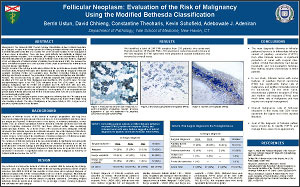Follicular Neoplasm: Evaluation of the Risk of Malignancy Using the Modified Bethesda Classification
Berrin Ustun, David Chhieng, Constantine Theoharis, Kevin Schofield, Adebowale J. Adeniran
Department of Pathology, Yale School of Medicine, New Haven, CT, USA
ABSTRACT
Background:
The Bethesda 2007 Thyroid Cytology Classification defines Follicular Neoplasm as a category of cases with cellular specimens showing abundant follicular cells arranged in a microfollicular pattern with little or no colloid. The current recommendation for the management of these cases is lobectomy. There has been great difficulty and variability in triaging and reporting follicular neoplasm. In our institution, this category is further subclassified into two: 1) Microfollicular patterned neoplasm (FN1) and 2) Follicular lesion with some features suggestive of but not diagnostic of follicular variant of papillary thyroid carcinoma (FN2). We reviewed the cases of follicular neoplasm seen over a period of three years to document the follow-up trend using this two-tier classification.
Design:
A search of the cytology records was performed for the period between January 2008 and December 2010. All thyroid FNA cases were reviewed and the ones with the diagnosis of follicular neoplasm (including Hurthle cell neoplasm) were identified. Correlating follow-up surgical pathology reports were reviewed. The percentage of cases showing a malignancy was calculated.
Results:
Two hundred and forty six cases of follicular neoplasm with surgical follow-up were identified (217 FN1 and 29 FN2). Malignancy was identified in 32% of all FN cases. This was disproportionately higher in the FN2 (72%) compared to the FN1 (27%) cases. In the FN1 category, malignancy rate for Hurthle cell neoplasm and FN, NOS were 28% and 26%, respectively. The malignant cases are largely follicular variant of papillary carcinoma. When the benign cases are further classified into neoplastic vs. non-neoplastic, 57% are neoplastic and are predominantly follicular adenoma and Hurthle cell adenoma, while 43% are non-neoplastic and are predominantly nodular goiter.
Conclusion:
The FN2 category requires a more aggressive follow-up than the FN1 category and justifies an immediate referral for lobectomy. The FN1 category may require further triage using other ancillary methods. The rate of malignancy in the present study is 32%, a higher end of previously reported values in the literature.
©2012 Yale Department of Pathology. All rights reserved.
Any redistribution or reproduction of part or all of the contents in any form is prohibited. You may not, except with express written permission of the author or the Department of Pathology, distribute or commercially exploit the content, nor may you transmit it or store it in any other website or other form of electronic retrieval system, including use for educational purposes.
